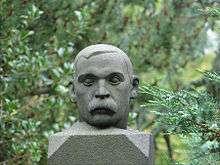Sigbjørn Obstfelder



Sigbjørn Obstfelder (21 November 1866 – 29 July 1900) was a 19th-century Norwegian writer and poet. [1]
Background
Obstfelder was born in Stavanger, Norway. He was the seventh child in a family of sixteen children born to Herman Friedrich Obstfelder (1828-1906) and Serine Egelandsdal (1836-1880). He began to study at the University of Christiania in 1886. Two years later he started studying engineering at Christiania Technical School (now Oslo ingeniørhøgskole). In 1890, he moved to Milwaukee, Wisconsin where he took a job as a draftsman at a bridge construction company. After only a year, he returned to Norway where he had a nervous breakdown and was briefly hospitalized in Christiania.[2][3]
Literary career
Primarily known as a writer of poetry, Obstfelder's debut collection of poems from 1893, Digte (Poems), is usually credited as one of the earliest examples of modernism in Norwegian literature. Despite producing only a mere handful of works during his short lifespan, he is considered one of the most important figures in Norwegian literature of the late 19th century. Strongly influenced by the French poet Charles Baudelaire, his writings have often been described as the literary equivalent of Edvard Munch's paintings; indeed, the two were friends. Obstfelder was a source of inspiration for Rainer Maria Rilke's work The Notebooks of Malte Laurids Brigge.[4]
Although known more for his poems, Obstfelder also wrote and published prose works. His first published prose were two short stories, which came out in 1895. The following year he published his famous novel Cross. In 1897, he published a play, The Red Dråbe, which was listed in the National Theatre in 1902. Several of his works were published posthumously, including the unfinished A Praest's Diary (1900). His journals from his stay in the U.S. were also published. In 2000, on the occasion of the 100th death anniversary of Obstfelder's death, a collection of his works was published.[5]
Contribution to Norwegian Poetry
Obstfelder is widely regarded as the first Norwegian modernist poet. His poems have left an indelible mark on Norwegian poetry. Choosing to depart from the traditional "rimtvangen" and the rigid structure of typical Norwegian verse, he created his own free verse, which was marked for its musicality. His poems are often tinged with anxiety, loneliness and alienation as well imparting a spiritual inclination. His poetry is considered by many to be the literary counterpart to expressionist art of Edvard Munch.[5]
Personal
Obstfelder lived most of his life as a pauper, and never stayed in one place for very long. By all accounts he had an unstable mental health, and suffered several nervous breakdowns. In 1898, he married the Danish singer Ingeborg Weeke (1876-1930), but it was a brief and turbulent marriage. He died of tuberculosis at the Municipal Hospital in Copenhagen at 33 years of age. He was buried at Frederiksberg Ældre Kirkegård on the same day his only child, Lili, was born. [6]
Memorials
Obstfelder's memory is celebrated in numerous cities in Europe. In 1917, his bust, created by Gustav Vigeland, was unveiled in the Stavanger city park. Another bust has been placed in the Frederiksberg Ældre Kirkegård at Frederiksberg in Copenhagen.[5]
Gallery
-

Cover of Obstfelder's Digte
-

Cover of Obstfelder's
To novelletter -

Cover of Obstfelder's
De røde Dråber -

Cover of Obstfelder's Korset
-

Cover of Obstfelder's
En Præsts Dagbog
Selected Works
- Digte (Poems), 1893
- To novelletter (Two novellettes), 1895
- Korset (The Cross, novel), 1896
- De røde dråber (The Red Droplets, a play), 1897
- En præsts dagbog (A Priest's Diary, novel), incomplete, released posthumously 1900
- Efterladte arbeider (Unfinished works), 1903
- Samlede skrifter I-III (Collected Writings), 1950 contains a lot of previously unreleased material
External links
References
- ↑ Øystein Rottem. "Sigbjørn Obstfelder". Store norske leksikon. Retrieved June 5, 2016.
- ↑ Hanne Lillebo. "Sigbjørn Obstfelder, Forfatter". Norsk biografisk leksikon. Retrieved June 5, 2016.
- ↑ "Oslo ingeniørhøgskole". Norsk senter for forskningsdata. Retrieved June 5, 2016.
- ↑ "Sigbjørn Obstfelder". Goodreads Inc. Retrieved June 5, 2016.
- 1 2 3 "Sigbjørn Obstfelder". Norwegian Encyclopedia AS. Retrieved 27 August 2013.
- ↑ "Family Card". A. S. Johannessen & L. Haegland. Retrieved June 5, 2016.